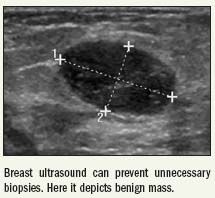Studies show how breast ultrasound reduces unnecessary biopsies
Breast ultrasound is having its moment. Multiple scientific presentations at the RSNA 2009 meeting showed how careful use of ultrasound could allow imagers to so precisely characterize lesions that women could avoid biopsies.
Breast ultrasound is having its moment. Multiple scientific presentations at the RSNA 2009 meeting showed how careful use of ultrasound could allow imagers to so precisely characterize lesions that women could avoid biopsies.
During one session investigators revealed ultrasound elastography could be an effective means of reducing unnecessary breast biopsy. During another, the researchers found targeted breast ultrasound by itself is also a safe and effective alternative to biopsies.
An ongoing study of 179 patients found ultrasound elastography correctly identified 98% of malignant lesions and 82% of benign lesions. Elastography also enabled researchers to accurately measure lesion size.
Standard B-mode ultrasound may underestimate some lesions as it visualizes only the actual mass and not its surroundings. Elastography measures the stiffness of a lesion and more easily distinguishes between a fluid-filled abnormality and a malignant cancer, said lead author of the study Dr. Stamatia Destounis, a radiologist at Elizabeth Wende Breast Care in Rochester, New York.
Elastography software, which allows testing of tissue elasticity with little transducer pressure, can be added to existing standard ultrasound equipment, she said. Potentially it can prevent unnecessary needle biopsies from taking place.
Another session showcased studies illustrating targeted breast ultrasound’s ability to decrease the harms and costs associated with unnecessary surgery.
Two retrospective studies of ultrasound examination for focal breast signs or symptoms (i.e., pain), one on women younger than 30, one on women between 30 and 39, were presented by senior investigator Dr. Constance D. Lehman, vice chair of radiology at the University of Washington in Seattle.

In one study, 1123 female patients under the age of 30 who underwent ultrasound for breast signs and symptoms were identified. Of 1091 lesions found in 830 patients, biopsy found cancer in three of 168 patients for whom the procedure was recommended. No other cancers were found in two years of follow-up.
The overall incidence of cancer in women under 30 is very low. Ultrasound has 100% sensitivity in this setting, which supports its use as a primary imaging modality, Lehman said.
The second study looked at 1327 cases identified in women between the ages of 30 and 39 who underwent both targeted ultrasound and mammography. Twentysix cases (2%) were found to be malignant; all of these were detected by ultrasound. None of the malignant cases, however, was detected by mammogram alone.
Lehman also discussed the possibility of using ultrasound, rather than doing a biopsy or performing surgery, to test BIRADS 3 lesions that are probably benign lumps. In the first study, a third of the patients with BI-RADS 3 lesions opted to undergo tissue sampling, and none were found to be malignant.
“With these data we can be much more reassuring to patients on the very low likelihood of malignancy in these probably-benign lesions. In fact, in our hands it was 0%,” said Lehman, who is also director of breast imaging at the Seattle Cancer Care Alliance.
New AI-Enabled Portable Ultrasound May Facilitate 50 Percent Reduction in Cardiac Imaging Scan Time
March 28th 2025Artificial intelligence (AI)-powered measurement capabilities provide key features with the Compact Ultrasound 5500CV device, which was unveiled at the American College of Cardiology (ACC) conference.
The Reading Room: Racial and Ethnic Minorities, Cancer Screenings, and COVID-19
November 3rd 2020In this podcast episode, Dr. Shalom Kalnicki, from Montefiore and Albert Einstein College of Medicine, discusses the disparities minority patients face with cancer screenings and what can be done to increase access during the pandemic.
Can Ultrasound-Based Radiomics Enhance Differentiation of HER2 Breast Cancer?
March 11th 2025Multicenter research revealed that a combined model of clinical factors and ultrasound-based radiomics exhibited greater than a 23 percent higher per patient-level accuracy rate for identifying HER2 breast cancer than a clinical model.